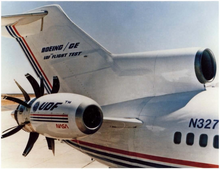General Electric GE36
The General Electric GE36 was an experimental aircraft engine, a hybrid between a turbofan and a turboprop, known as an unducted fan (UDF) or propfan.
General Electric (GE) started performing studies and component test work on the concept that would become the UDF in 1981, based on the initial results of early National Aeronautics and Space Administration (NASA) propfan technology studies that the aerospace agency first released to engine makers in 1980.
The UDF production engines would be 10 ft (3.0 m) in diameter, produce 10,000 hp (7,500 kW), and power airplanes in the 120-160 seat market.
[4] Later in the decade, the GE36 became the power plant of choice for proposed aircraft such as the Boeing 7J7 twin-aisle airliner and the MD-91 and MD-92 derivatives of McDonnell Douglas's popular MD-80 single-aisle airplane.
[19] At the Paris Air Show in June 1987, GE and Snecma noted that they were building the components for a product design engine that would test on a Boeing 727 in 1989.
[26] After the testbed was reconfigured with the 8x8 engine setup, McDonnell Douglas conducted 22 customer demonstration flights from the Long Beach Airport.
[29] The general opinion was that the ride quality was little different than a normal flight, except for light vibration in the back seat during takeoff and climb.
[32] The testbed airplane was then flown across the Atlantic Ocean, leaving its home test airfield of Edwards Air Force Base in California to stop in Minneapolis, Minnesota, Gander, Newfoundland, Canada, and Keflavik, Iceland before ending the 4,700 nmi trip (5,400 mi; 8,700 km) in Farnborough Airport in England on August 23.
The trip was made to perform daily public demonstration flights at the Farnborough Air Show on September 4–11, 1988.
[33] Private flight demonstrations for invited airline executives were to be given before the air show, and McDonnell Douglas was considering flying the testbed to Western Europe before returning to the US.
[14] With demonstrator flight testing completed, the focus moved to construction of a new core (instead of the off-the-shelf F404) to increase efficiency.
At the time of the project cancellation later in 1989, GE and Snecma were working on the design engineering of a full gas generator and a product propulsor.
[citation needed] Even though these engines never made it past development and prototype testing, GE has retained the carbon composite technology behind the lightweight fan blades.
Each stage was a pair of rotors; there were no stators (static vanes), which usually follow the single-rotor section to straighten out the flow.
[60] The engine demonstrated an extremely low specific fuel consumption (SFC) of 0.232 lb/(lbf⋅h) (6.6 g/(kN⋅s)) at ground level,[61] which GE claimed was over 20% more efficient than any of the existing turbofans on offer.
[66] The engine configuration selected for the MD-91 and MD-92 was designed to meet the Chapter 4 community noise standards of the International Civil Aviation Organization's (ICAO's) Committee on Aviation Environmental Protection (CAEP), which would go into effect in 2006 and be a reduction of ten effective perceived noise decibels (EPNdB) from the existing Chapter 3 standards that were established in 1977.




